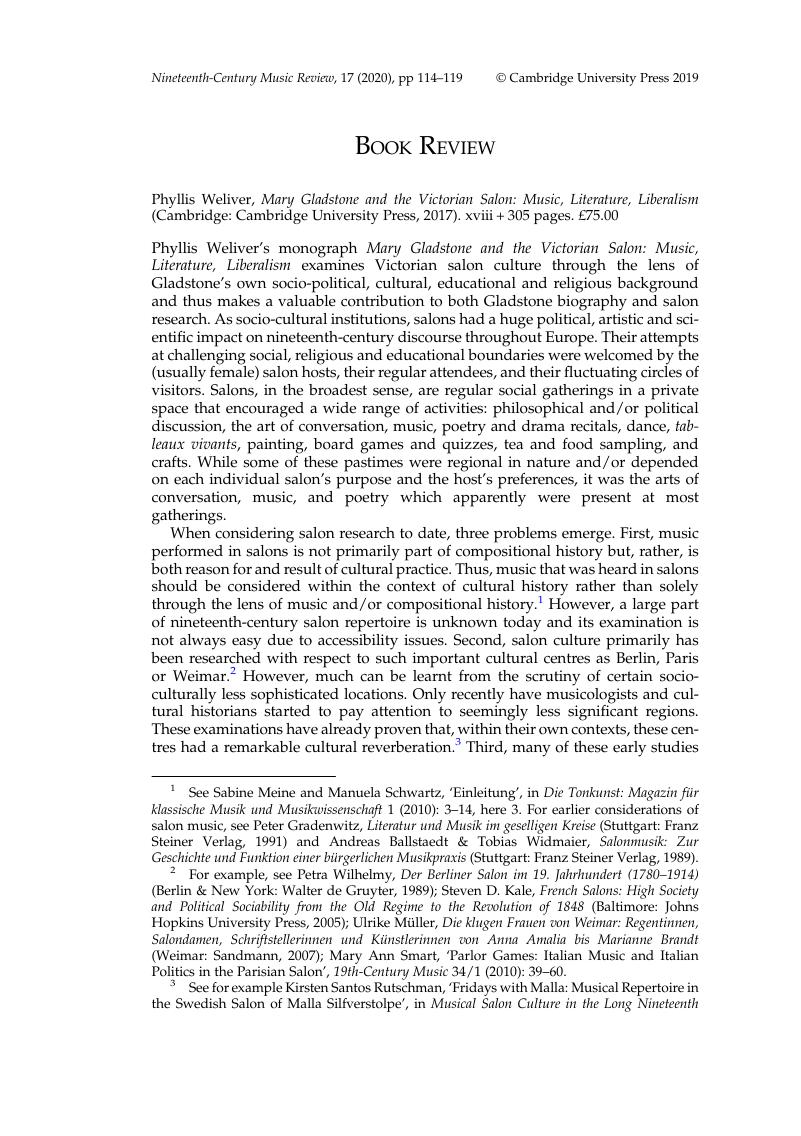No CrossRef data available.
Article contents
Phyllis Weliver, Mary Gladstone and the Victorian Salon: Music, Literature, Liberalism (Cambridge: Cambridge University Press, 2017). xviii + 305 pages. £75.00
Published online by Cambridge University Press: 05 September 2019
Abstract

- Type
- Book Reviews
- Information
- Copyright
- Copyright © Cambridge University Press 2019
References
1 See Meine, Sabine and Schwartz, Manuela, ‘Einleitung’, in Die Tonkunst: Magazin für klassische Musik und Musikwissenschaft 1 (2010): 3–14, here 3Google Scholar. For earlier considerations of salon music, see Gradenwitz, Peter, Literatur und Musik im geselligen Kreise (Stuttgart: Franz Steiner Verlag, 1991)Google Scholar and Ballstaedt, Andreas & Widmaier, Tobias, Salonmusik: Zur Geschichte und Funktion einer bürgerlichen Musikpraxis (Stuttgart: Franz Steiner Verlag, 1989)Google Scholar.
2 For example, see Wilhelmy, Petra, Der Berliner Salon im 19. Jahrhundert (1780–1914) (Berlin & New York: Walter de Gruyter, 1989)CrossRefGoogle Scholar; Kale, Steven D., French Salons: High Society and Political Sociability from the Old Regime to the Revolution of 1848 (Baltimore: Johns Hopkins University Press, 2005)Google Scholar; Müller, Ulrike, Die klugen Frauen von Weimar: Regentinnen, Salondamen, Schriftstellerinnen und Künstlerinnen von Anna Amalia bis Marianne Brandt (Weimar: Sandmann, 2007)Google Scholar; Smart, Mary Ann, ‘Parlor Games: Italian Music and Italian Politics in the Parisian Salon’, 19th-Century Music 34/1 (2010): 39–60CrossRefGoogle Scholar.
3 See for example Rutschman, Kirsten Santos, ‘Fridays with Malla: Musical Repertoire in the Swedish Salon of Malla Silfverstolpe’, in Musical Salon Culture in the Long Nineteenth Century, ed. Bunzel, Anja and Loges, Natasha (Woodbridge: Boydell, 2019), 79–94Google Scholar; Harald Krebs, ‘Josephine Lang and the Salon in Southern Germany’, in Musical Salon Culture in the Long Nineteenth Century, 199–210; and Mullaney-Dignam, Karol, ‘“French Horns Playing at Every Meal” and Musical Activity at Carton, 1747–1895’, in Aspects of Irish Aristocratic Life: Essays on the FitzGeralds and Carton House, ed. Dooley, Terence, Cosgrove, Patrick J. and Mullaney-Dignam, Karol (Dublin: UCD Press, 2014), 92–105Google Scholar.
4 Hahn, Barbara, ‘Der Mythos vom Salon’, in Salons der Romantik: Beiträge eines Wiepersdorfer Kolloquiums zu Theorie und Geschichte des Salons, ed. Schulz, Hartwig (Berlin: de Gruyter, 1997), 213–34, especially 229Google Scholar. Hahn scrutinises socio-cultural implications of Levin's salon through the lens of Levin's acquaintance Karl Gustav Brinckmann's (1764–1847) correspondence with the countess Luise von Voss (1780–1865) on the one hand and with his Jewish friends on the other.
5 Brantlinger, Patrick, ‘Bohemia Versus Grub Street: Artists’ and Writers’ Communities in Nineteenth-Century Paris and London’, Mosaic 16/4 (1983): 25–42Google Scholar; Kelly, Linda, Holland House: A History of London's Most Celebrated Salon (London: Tauris, 2015)Google Scholar; Logan, Thad, The Victorian Parlour: A Cultural Study (Cambridge: Cambridge University Press, 2001)Google Scholar; Schmid, Susanne, British Literary Salons of the Late Eighteenth and Early Nineteenth Centuries (New York: Palgrave Macmillan, 2013)CrossRefGoogle Scholar; Prendergast, Amy, Literary Salons Across Britain and Ireland in the Long Eighteenth Century (Basingstoke: Palgrave Macmillan, 2015)CrossRefGoogle Scholar; Zon, Bennett, ed., Music and Performance Culture in Nineteenth-Century Britain (Farnham: Ashgate, 2012)Google Scholar; Hoffmann, Freia, ‘Netzwerke von Musikerinnen in Paris und London’, Musikerinnen und ihre Netzwerke im 19. Jahrhundert, ed. Babbe, Annkatrin and Timmermann, Volker (Oldenburg: BIS, 2016), 149–61Google Scholar.
6 Wilhelmy, Petra, Der Berliner Salon im 19. Jahrhundert (1780–1914) (Berlin: Walter de Gruyter, 1989)CrossRefGoogle Scholar; Chimènes, Myriam, Mécènes et musiciens: Du salon au concert à Paris sous la IIIe République (Paris: Fayard, 2004)Google Scholar; Kale, Steven D., French Salons: High Society and Political Sociability from the Old Regime to the Revolution of 1848 (Baltimore: Johns Hopkins University Press, 2005)Google Scholar; Borchard, Beatrix and Zimmermann, Heidy, eds, Musikwelten – Lebenswelten: Jüdische Identitätssuche in der deutschen Musikkultur (Cologne: Böhlau, 2009)Google Scholar; Müller, Ulrike, Die klugen Frauen von Weimar: Regentinnen, Salondamen, Schriftstellerinnen und Künstlerinnen von Anna Amalia bis Marianne Brandt (Weimar: Sandmann, 2007)Google Scholar; Smart, ‘Parlor Games’; Vincent, K. Steven, ‘Elite Culture in Early Nineteenth-Century France: Salons, Sociability, and the Self’, Modern Intellectual History 4 (2007): 327–51CrossRefGoogle Scholar; Lilti, Antoine, The World of the Salons: Sociability and Worldliness in Eighteenth-Century Paris, trans. Cochrane, Lydia (Oxford: Oxford University Press, 2015)Google Scholar; Bilski, Emily D. and Braun, Emily, eds, Jewish Women and Their Salons: The Power of Conversation (New York: The Jewish Museum, 2005), 1–21Google Scholar.
7 For instance, Mary Shaw travelled to Berlin to visit Fanny Hensel and her mother Lea Mendelssohn following Felix's recommendation in February 1839, and Johanna Mathieux passed through Leipzig on her way from Berlin to Bonn one month later. See Anja Bunzel, ‘Johanna Kinkel's Social Life in Berlin (1836–39): Reflections on Historiographical Sources’, in Musical Salon Culture in the Long Nineteenth Century, 13–26, especially 18 and 24.
8 For example, Klein, Hans-Günter, ‘… mit obligater Nachtigallen- und Fliederblütenbegleitung’: Fanny Hensels Sonntagsmusiken (Wiesbaden: Reichert, 2005)Google Scholar; Klein, Hans-Günter, ed., Die Musikveranstaltungen bei den Mendelssohns – Ein ‘musikalischer Salon’?: Die Referate des Symposions am 2. September 2006 in Leipzig (Leipzig: Mendelssohn-Haus, 2006)Google Scholar; Borchard, Beatrix and Schwarz-Danuser, Monika, Fanny Hensel: Komponieren zwischen Öffentlichkeit und Privatheit: Symposionsbericht Berlin 1997 (Stuttgart, 1999; second edition Kassel, 2002)Google Scholar; Bodley, Lorraine Byrne, ‘In Pursuit of a Single Flame: Fanny Hensel's “Musical Salon”’, in Women and the Nineteenth-Century Lied, ed. Kenny, Aisling and Wollenberg, Susan (Farnham: Ashgate, 2015), 45–59Google Scholar.
9 For details on blurred boundaries between the private and public, amateurism and professionalism in the nineteenth-century salon see Aisling Kenny, ‘Blurring the Gendered Dichotomies: Issues of Gender and Creativity for the Female Lied Composer’, in Women and the Nineteenth-Century Lied, 11–27.




